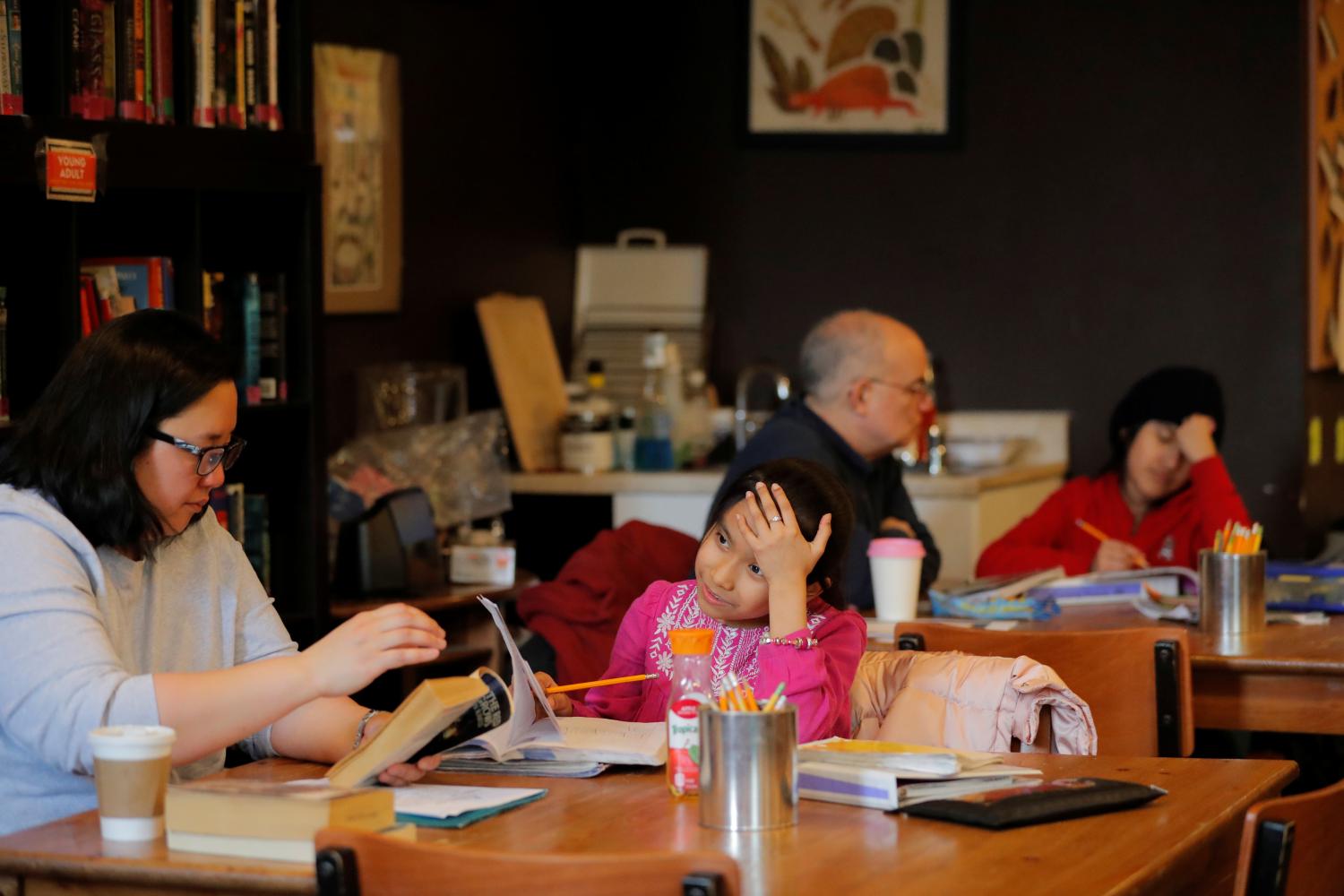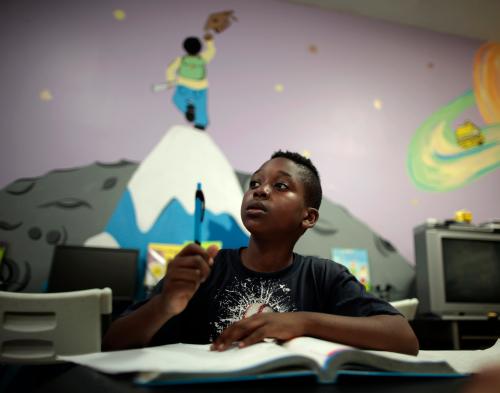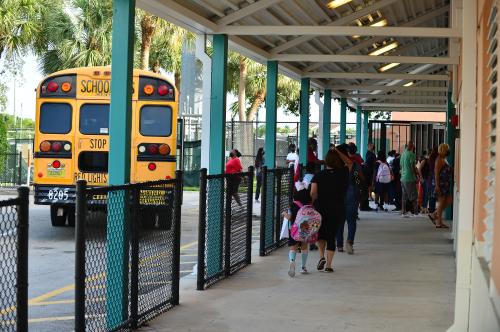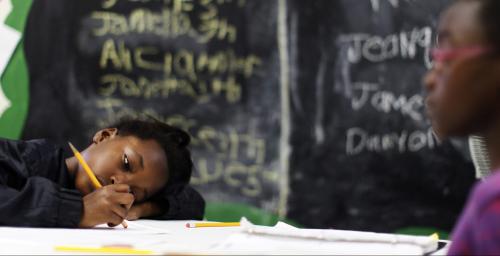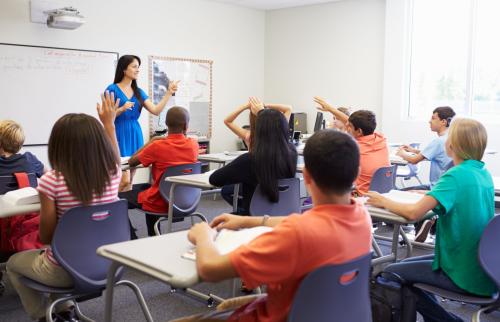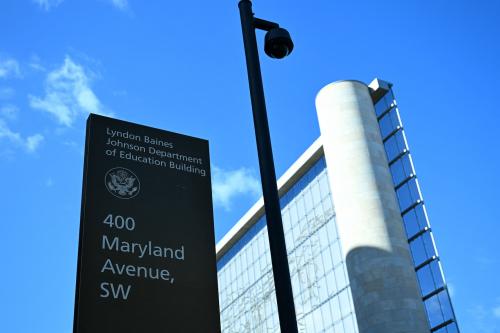More than two and a half years later, the cumulative effects of the COVID-19 pandemic on children and their caregivers are coming into clear view. Surveys of both parents and educators highlight concerning trends in children’s emotional well-being and mental health. These concerns are heightened for children of color, who were significantly more likely to lose a parent or caregiver from a COVID-19 related death. Recent research evaluating the effects of the pandemic on students’ learning trajectories reflects this reality. Learning rates slowed during the pandemic for most students, and even more so for students of color and students from low-income families.
To support students, families, and schools in recovering from the varied harms of the pandemic, Congress has provided U.S. public schools with $190 billion in federal relief aid over the last three years. Many school districts are using some of these resources to fund academic interventions like summer and after-school programs and high-dosage tutoring that families can sign their children up for.
News reports and recent research indicate that participation in these opt-in recovery programs may be low. Some researchers argue that low participation rates indicate low levels of parent interest in academic recovery efforts. However, a broader literature on family engagement in education suggests that insights gleaned from families’ participation in recovery programs may be limited.
Here, we interrogate what we do and do not know about families’ interest in and engagement with COVID-19 recovery programs based on the limited research to date. We also summarize broader literatures on family engagement that can support education leaders working to better engage families in COVID-19 relief efforts.[1]
Surveys of Families Provide Limited Insights
First, let’s understand what we do and do not know about parents’ interest in COVID-19 recovery programs. According to a recent nationally representative survey, low shares of parents were interested in enrolling their child in either tutoring (28%) or summer school (23%) in spring 2022. Results from the same survey reported elsewhere show significant variation by family background, with Black, Asian, Latino, and low-income families significantly more likely to express interest in academic recovery programs relative to White and more affluent families. For example, about 35% of Black parents expressed interest in summer school compared to less than 20% of White families, with similarly large differences observed for interest in tutoring.
How the authors define parent interest is an important limitation of these results (a limitation the authors acknowledge). In particular, the survey uses parents’ participation in recovery programs (conditional on being offered an available seat) as a proxy for parents’ interest. This definition likely underestimates parents’ interest in academic recovery programs. This is because families’ participation in recovery interventions is almost certainly influenced by factors unrelated to their interest—e.g., program eligibility rules, scheduling issues, and transportation access. Put another way, this definition does not account for barriers families may face in accessing COVID-19 recovery programs for their children.
More importantly, these survey results leave unanswered critical questions as to why reported participation rates may be low.
One hypothesis that some researchers have put forth is that parents are overly optimistic about their children’s academic recovery from the effects of the pandemic. For example, according to a survey released earlier this fall by Education Next, 43% of parents report that their children did not experience any learning losses during the pandemic.
These results are being framed as potentially worrisome in part because they do not comport with researchers’ understanding of the breadth and magnitude of pandemic harm on test score growth. This misalignment may be driven by differences in the types of information available to parents relative to the information used in academic research.[2]
Regardless, the research to date leaves unanswered questions that are important for ensuring the success of COVID-19 recovery efforts in schools. Questions like: How do parents understand their children’s academic and emotional well-being needs in the context of COVID-19 recovery? How are parents making decisions about whether they enroll their children in COVID-19 recovery interventions? And what potential barriers are families encountering in accessing these resources?
What can research tell us about how to effectively engage families in schools’ COVID-19 recovery programs?
Research emphasizes the important roles that parents and families play in children’s learning and development. If COVID-19 recovery efforts are going to meaningfully aid students and their families, family engagement must be a critical component of those efforts. Work in this area makes an important distinction between family involvement and family engagement.
School-Driven Family Involvement Has Limitations
Family involvement is typically characterized by structured ways for parents to support their child’s learning as prescribed by schools. For example, family involvement includes activities like attending parent-teacher conferences, chaperoning school field trips, and engaging in other volunteer activities, but can also take the form of participation in school-based decision-making bodies like parent-teacher organizations.
While some research suggests activities like this support student learning, other scholars argue that those effects can be explained by ethno-racial and socio-economic differences in the types of parents (e.g., white, middle-class parents) most likely to engage in prescribed forms of family involvement. For example, one study found that while family involvement activities such as attending parent-teacher conferences, PTO membership, volunteering at school, and homework checking are positively associated with test scores, this relationship is notably weaker—and perhaps even negative—after accounting for students’ race/ethnicity, socio-economic status, and baseline test scores.
Indeed, scholars have cautioned that families from less socio-economically advantaged backgrounds and families of color often encounter significant barriers to participating in schools in these highly prescribed ways. For example, one study found that negative interactions with teachers and other parents, as well as scheduling challenges, limited Black parents’ involvement with school-based activities.
Moreover, conceptualizing family involvement in narrow ways that are not inclusive of families who may have less time to donate or less relational trust with educators can exacerbate educational inequalities. For example, research shows that family involvement often yields additional benefits to highly involved (typically more affluent, white) families while simultaneously perpetuating negative stereotypes about less involved families (typically low-income families and families of color).
In the context of this research, recent surveys and reports showing low family uptake of academic recovery programs may be telling us more of what we already know: when schools expect families to engage in highly prescribed ways without sufficient stakeholder engagement, families may not participate. Claims that parents lack “interest” in their children’s education based on participation rates ignore existing structures and practices that limit parents’ participation in schools and incorrectly shift blame for educational inequalities onto families.
Partnership-Driven Family Engagement Shows Promise for COVID-19 Recovery
Moving beyond prescriptive roles for parents, family engagement is characterized by reciprocal relationships (grounded in relational trust) between educators and families—with the goal of working as partners to support student learning and school improvement. According to one scholar of community organizing for school reform, “parental engagement designates parents as citizens in the fullest sense—change agents who can transform urban schools and neighborhoods.” For example, family engagement practices include educators and families working in partnership to co-design engagement agendas, strategies, and initiatives, and consistently seeking out families’ expertise in the education of their children—all with the aim of sharing decision-making power with families and communities.
Research demonstrates that family engagement has many benefits, including promoting the success of school reform efforts, deepening leaders’ and educators’ understanding of stakeholder perspectives, and supporting child development outcomes. Justice-based approaches to family engagement recognize families as experts who can help build more equitable education systems. And considering the inequality-intensifying effects of the pandemic, it is critical that any engagement work is inclusive of all families, particularly communities of color, low-income families, and immigrant families.
How can schools develop stronger approaches to family-school engagement? A report recently commissioned by the Carnegie Corporation of New York outlines a research-based framework—the Dual Capacity-Building Framework for Family-School Partnerships–for developing strong family-school engagement that is grounded in anti-racist and social justice principles. This framework argues that for schools to meaningfully improve family-school engagement, schools need to build capacity for this type of partnership work among both educators and families and work to improve certain organizational conditions necessary for family-school partnerships to be successful. (For additional ideas on strategies schools can pursue to improve family-school partnerships, see work by our colleagues in Brookings’ Center for Universal Education.)
Some of our own research in Michigan suggests that strong relationships with families helped insulate schools from the worst outcomes during the pandemic. Districts that demonstrated better-than-predicted achievement growth in the 2020-2021 school year engaged in consistent and clear two-way communication with families. Further, these districts had strong existing relationships with families that provided a foundation for effectively supporting student learning during crisis.
Moving Towards a Family-Centered Approach to COVID-19 Recovery
Recent surveys of parents above all else underscore that family engagement in COVID-19 recovery efforts cannot be an afterthought. Family engagement in COVID-19 relief spending is a priority for the Biden-Harris administration. Yet, low shares of states and districts included explicit family engagement strategies in their COVID-19 spending plans.
Some education policy experts are recommending that districts consider adopting opt-out policies where opt-in participation is low. We argue that where opt-in rates are low, district and school officials should interpret that as a clear signal that parents and families have not been sufficiently engaged in decision-making. One lesson emerging from early work on implementing COVID-19 academic recovery programs is that family engagement is critical to a program’s success. Before making voluntary programs mandatory, school leaders and educators should engage with families and students to understand why participation rates were low in the first place and determine together what adjustments should be made.
COVID-19 relief funding provides a unique opportunity to rebuild public education after an exceptionally challenging two years. As Anne Ishimaru and Megan Bang have argued, we need to “recast families and communities as co-designers of education” rather than conceptualizing families as the recipients of services or even worse as barriers to implementation.
The road ahead for districts and schools will be challenging. Family engagement efforts will have to contend with the historic failures of school systems to effectively serve marginalized communities. Researchers can aid these efforts by fostering research-practice partnerships focused on developing family engagement practices grounded in educational equity. Without these efforts, school districts risk spending limited COVID-19 relief aid on programs and initiatives that don’t meet the needs of students and families and won’t remedy pandemic harms on student learning.
Footnotes:
[1] Note that we use the terms “parent” and “family” interchangeably as both are used in this literature. We use “parent” to describe any family member or other adult in a caregiving role. Although, we rely more on the term “family” to acknowledge the diverse contexts in which children are cared for. (Back to top)
[2] Several academic studies that estimate the effects of the pandemic on test score growth do so by using large administrative datasets and comparing students’ rates of learning during the pandemic to pre-pandemic trends in student learning. (Back to top)
The Brookings Institution is committed to quality, independence, and impact.
We are supported by a diverse array of funders. In line with our values and policies, each Brookings publication represents the sole views of its author(s).



